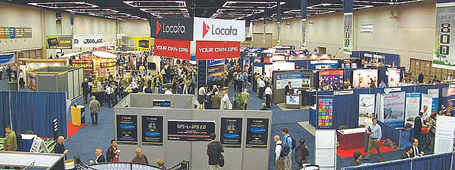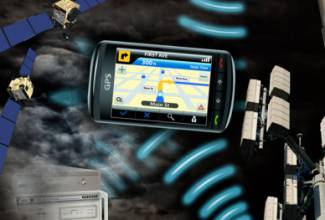
In his State of the Union address on January 25, President Obama held up the Global Positioning System as a prime example of government providing “cutting-edge scientists and inventors with the support that they need” to create world-leading, job-creating innovation.
The following day, the Federal Communications Commission (FCC) International Bureau approved a conditional waiver allowing LightSquared Subsidiary LLC to build tens of thousands of terrestrial transmitters for wireless communications in frequencies on either side of the GPS L1 band.
In his State of the Union address on January 25, President Obama held up the Global Positioning System as a prime example of government providing “cutting-edge scientists and inventors with the support that they need” to create world-leading, job-creating innovation.
The following day, the Federal Communications Commission (FCC) International Bureau approved a conditional waiver allowing LightSquared Subsidiary LLC to build tens of thousands of terrestrial transmitters for wireless communications in frequencies on either side of the GPS L1 band. Reportedly, the transmitters are authorized to operate at 42 dBW (15 kilowatts) of power.
In a response similar to that of the ultrawideband controversy nearly 10 years ago, the GNSS community has expressed dire concern that, if implemented, the Lightsquared initiative could cause serious problems for millions of users in the United States.
Letters to the FCC calling for a more substantive technical evaluation before allowing LightSquared to proceed came from the U.S. GPS Industry Council (USGIC) and the National Telecommunication & Information Administration (NTIA), a U.S. Department of Commerce agency that serves as the President’s principal adviser on telecommunications and information policy.
The Air Force has asked the Aerospace Corporation, a federally funded research and development organization that works closely with the GPS Directorate, to assess whether the LightSquared plan would create problems for GPS receivers.
A December 23 USGIC issue paper characterized the LightSquared proposal as “a radical change in the spectrum environment for GPS” that “has the strong potential to cause interference. . . .”
In a January 16 report, GARMIN International described a recent test evaluating the effects of proposed LightSquared broadcasts on two of its most popular receivers: a GNS 430W FAA-certified general aviation receiver and a nüvi 265W portable navigation device. Both lost open-sky positioning capability at a distance 5.6 to 0.66 miles, respectively.
The company’s conclusion: “If this [FCC-LightSquared] modification is approved, widespread, severe GPS jamming will occur.”
Technically, the FCC action grants LightSquared a waiver to its ancillary terrestrial component (ATC) “integrated service” rule, which requires mobile satellite services (MSS) that have a ground transmission infrastructure to provide only combined satellite/terrestrial user equipment.
According to the FCC order, “Although LightSquared does not, itself, intend to offer ATC-only subscriptions to its wholesale customers, it contemplates that its customers may well offer ATC-only subscriptions to consumers.”
In effect, LightSquared’s application “proposes to fundamentally change the usage of the L Band 1 spectrum (1525 MHz-1559 Mhz) from MSS (very low power, space to earth signals) to fixed, high power terrestrial broadband service,” Garmin argued.
LightSquared is working to gain access to 20 megahertz or more of L-band spectrum allocation, including a $ $337.5 million purchase from Inmarsat. With that resource, it would offer the first-ever wholesale nationwide 4G-LTE wireless broadband network integrated with satellite coverage for its customers to offer terrestrial-only, satellite-only, or integrated satellite-terrestrial services to end users.
The FCC ruling does acknowledge “the need to address the potential interference concerns regarding GPS,” and requires “As a condition of granting this waiver, the [interference review] process . . . must be completed to the Commission’s satisfaction before LightSquared commences offering commercial service pursuant to this waiver on its L-band MSS frequencies.”
However, the ruling also requires LightSquared to begin implementing its system and assuring the availability of user equipment within a matter of months. Moreover, concern exists among that the solution to any interference problem could be placed on the backs of GNSS receiver manufacturers who would need to incorporate expensive design changes in user equipment.
LightSquared told the FCC that it is investing more than $50 million to underwrite the costs of developing a Qualcomm dual-mode chipset, related components, and an associated satellite ground station infrastructure.
In a January 21 filing with the FCC, Qualcomm, a large-scale manufacturer of integrated GPS and wireless communications chips, described how it has protected its assisted-GPS (AGPS) solution against self-interference from the phone’s cellular uplink transmitter at 1710 MHz, 135 megahertz away from the GPS L1 band. The company admitted that it didn’t know if the receiver filter it used to prevent the uplink interference would also serve for an L-band downlink.
“Qualcomm is now in the process of evaluating the extent of interference from LightSquared L Band LTE base stations (i.e., downlink) into the GPS receivers of cell phones using Qualcomm’s AGPS solution, particularly legacy phones already in the market today, given the close proximity of the L and GPS L1 bands,” wrote Dean R. Brenner, Qualcomm’s vice-president for government affairs.
Moving Quickly
Backed by billions of dollars from principal investor Harbinger Capital Partners, LightSquared — which was only formed last July — is on the fast track to implementing its MSS system.
The company has assembled a cast of luminaries from the wireless telecom community, including Chairman and CEO Sanjiv Ahuja, former CEO of UK wireless giant, Orange; Chief Marketing Officer, Frank Boulben, formerlyn global director of commercial strategy for the Vodafone Group; and Chief Network Officer Douglas Smith, who left a position as senior vice-president, engineering and operations, for Clearwire, a nationwide mobile broadband WiMAX network with majority ownership by Sprint.
In September 2010, LightSquared disclosed an eight-year, $7-billion agreement for Nokia Siemens Networks to deploy, install, operate and maintain the LightSquared nationwide network.
The company’s effort is aided by Goldberg Godles Wiener & Wright, a Washington, D.C.–based telecommunications law firm whose senior policy advisor is Thomas Tycz, who joined the firm in 2005 from his position as head of the FCC International Bureau’s Satellite Division.
Tycz’s experience at the FCC presumably would have aided LightSquared in moving its waiver request — which coincided with the busy Thanksgiving/Christmas holiday season — quickly through the agency’s procedural channels.
Ironically, given Obama’s State of the Union shout-out for GPS, the LightSquared situation is driven in part by the president’s own initiative, Unleashing the Wireless Broadband Revolution, issued in June 2010. In it, Obama committed to make available 500 megahertz of Federal and nonfederal spectrum over the next 10 years.
The Garmin Tests
The rapid emergence and evolution of the LightSquared initiative clearly caught the GNSS community off guard, and the accelerated FCC process has allowed little time for a technical evaluation of its side effects before the fact.
Consequently, the Garmin testing effort provides a key data point — especially considering that Garmin claims to have provided more than 90 percent of the current general aviation GPS receivers and 50 percent of the automotive and handheld equipment now operating in the United States.
Using a Spirent GSS6560 GPS simulator, a Rohde & Schwartz SMIQ-03S signal generator, and an Agilent N9020A spectrum analyzer to measure output power of the simulated LightSquared transmitter, Garmin engineers set up a test scenario with the receivers in an RF shielded, anechoic chamber to measure the likely real-world effects of the LightSquared terrestrial network.
In their report, the Garmin engineers said they took care “to err in LightSquared’s favor whenever assumptions were made about its transmissions.” For example, although an FCC order allows a transmitter antenna to emit 42 dBW EIRP (effective isotropic radiated power) up to the 1559 MHz band bordering GPS L1, the test setup used a LightSquared “verbal guidance” that they would not transmit in excess of 32 dBW EIRP at 1555 megahertz.
The simulated scenario also assumed GPS satellite signals (40 db-Hz carrier/noise ratio) and a stationary receiver, which would eliminate dynamic effects, fading, and so forth.
Under these conditions, the nüvi receiver detected simulated LightSquared jamming at 3.57 miles and would have lost service in an urban canyon environment if the transmitter was 1.79 miles away or closer, according to Garmin.
For the aviation receiver, effects were even more marked: it detected the jamming at 13.76 miles and experienced a 10-decibel loss of sensitivity at 9.85 miles.
FCC Conditions
With its conditional waiver for LightSquared, the FCC is ostensibly taking its responsibility seriously to ensure non-interference with existing services.
Agency staff will be directed to “work with NTIA, LightSquared, and the GPS community, including appropriate Federal agencies, to establish a working group to fully study the potential for overload interference to GPS devices and to identify any measures necessary to prevent harmful interference to GPS.”
In fact, the Institute of Navigation, which has long hosted the leading GNSS conferences, wrote to the agency on January 26, offering to help identify “technical experts who might best assist the FCC in evaluating risks and impacts of LightSquared’s proposal.”
However, the phrasing in the conditions set by the FCC seems to suggest an assumption that LightSquared will be accommodated, directing that the working group provide “recommendations on steps that can be taken going forward to permit broadband wireless services to be provided in the L-Band MSS frequencies and coexist with GPS devices.”
Moreover, the burden of proof appears to rest on the GPS community.
“Because the GPS interference concerns stem from LightSquared’s transmissions in its authorized spectrum rather than transmissions in the GPS band,” the FCC order reads, “the Commission expects full participation by the GPS industry in the working group and expects the GPS industry to work expeditiously and in good faith with LightSquared to ameliorate the interference concerns.”
In addition, LightSquared is charged with preparing the information for the agency; no other organization or group
And the compressed timeline for dealing with the issue continues: An initial report and workplan by February 25 and a final report by June 15, 2011, “that includes the working group’s analyses of the potential for overload interference to GPS devices from LightSquared’s terrestrial network of base stations, technical and operational steps to avoid such interference, and specific recommendations going forward to mitigate potential interference to GPS devices.”





